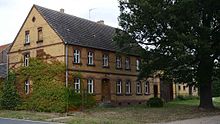Four-sided courtyard



A Vierseithof is the name of a farmstead layout in which the agricultural farm yard is enclosed on all four sides of buildings, ie generally from the house , the (regional variations indicated) Stadel or the barn , the granary , granary , granary or granary and the stable . This form of agricultural property has become widespread. It is similar to the shape of the square yard in Austria .
With slight differences in the purpose and arrangement of the buildings, the topographical location in the area and in the design (fencing, walling), the four-sided courtyard is a very characteristic type of courtyard.
Germany
In central Germany , the four-sided farm is the wealthiest form of farm. The residential building limits the inner courtyard to the street and can be built from half-timbered (often only the upper floor), bricks or quarry stone . In Thuringia and parts of Saxony it is mostly two-story, in Saxony-Anhalt almost always one -story . In the Magdeburger Börde , plastered brick buildings predominate, which are often provided with classicistic stucco decorations , which are typical of the former Prussia , as they are otherwise known from 19th century townhouses. The outbuildings mostly have unplastered brickwork, half-timbering or wooden battens.
The form of the Vierseithof still occurs in Lower Bavaria , especially in the Rottal ( Rottaler Vierseithof ) and Inntal , at the so-called Franconian homesteads in Upper Franconia and in the Egerland , Altenburger Land , Spreewald , Rhineland , Hesse , Altmark and Fläming . In contrast to the Spreewälder and Bohemian four-sided courtyards, the Altenburg four-sided courtyards are particularly eye - catching because of their unique size.
Austria
In Austria , this type of court is found particularly in eastern Styria , in the Innviertel and Mühlviertel .
At the Innviertler Vierseithof the four buildings are grouped around the courtyard in such a way that the corners of the courtyard are only closed off by gate walls or fences. In Upper Austria and bordering Lower Austria there is an area of the Vierkanthof , which in its completely closed system as a single building can be clearly separated from the local four-sider.
In contrast, the Oststeirische Vierseithof is already completely closed in terms of its floor plan, but the roof on the courtyard entrance side has two gables. In the north of Eastern Styria, instead of the at least partial walling, there is also a block built in accordance with the natural conditions , which is sometimes called the Ringhof .
Czech Republic and Poland
Both in the Czech Republic and in Poland , four-sided farms can be found in the loess loam belt from Egerland to Eastern Bohemia and in southern and western Silesia as far as Lesser Poland .
Denmark
Four-sided courtyards have been and are common nationwide in Denmark since the 16th century.
See also
literature
- Vinzenz Dufter: The four-sided courtyard in the settlement structure development from 1856 - 2000; shown to Frauenhaselbach, City of Neumarkt-St. Veit, Mühldorf district, dissertation at the Technical University of Munich 2004
- Open Monument Day History up close: Living in a monument; September 14, 2003; Vierseithof Georg Schurm in Ruhmannsdorf, City of Hauzenberg, 2003
- Christian Soika: Restoration of a four-sided farm in Lampertsham No. 7, Parish Palling, in: Heimatpflege-Notizen, 1993
- Josef Egginger: From Haufen- to Vierseithof, in: Bayerisches Kulturmosaik, 1989
- Franz Hart : A renewed four-sided courtyard in Lower Bavaria, in: Der Bauberater, 1993
- Georg Baumgartner: The Kochhof, a Lower Bavarian four-sided farm in the Massing open-air museum, around 1982/1983
Individual evidence
- ↑ 'Landhuset', Gyldendalske Boghandel, Nordisk Forlag A / S, 1975

